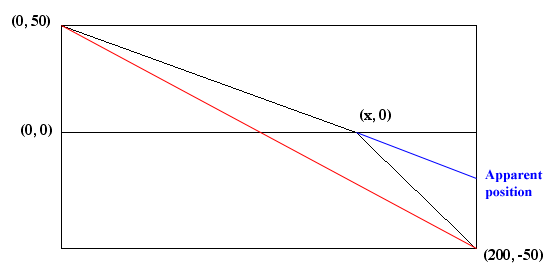
Think about the times you've been at the beach or a swimming pool or fishing. When you look at people standing waist deep in water, their images are changed by the water. First, you usually see their reflections in the water's surface -- upside-down from your point of view. Second, the appearance of their submerged parts is usually shortened by a phenomenon called refraction. In this module we study refraction, and we investigate how refraction affects what a fish sees when it looks at a fisherman.
Welcome to Fermat's Pond. Like a real pond, Fermat's Pond is somewhat complicated. The live figure below has three panels arranged side-by-side. The middle panel shows a picture of a fisherman who is standing in water that is approximately three feet deep. The fisherman wouldn't look like this, however, because the water would distort his appearance. The right panel shows how the fisherman would actually appear. Notice both the reflection in the water and the way that the submerged part of the fisherman is shortened.
Exactly how the water distorts his appearance depends on your view point. The diagram to the left shows how all this happens. In this diagram the fisherman is standing at the black line separating the diagram from the picture of the fisherman. Your eye is represented by a black dot toward the left side of the diagram. There are several lines representing light rays arriving at your eye -- notice that each light ray coming from the water's surface can come from two different sources. One is shown with a red line that represents a ray reflected by the surface of the water. The other is shown with a blue line representing a ray that is bent as it passes from the water to the air.
The bottom of Fermat's pond is green. Notice in the right panel the bottom appears to be higher than it actually is. You can see how the fisherman's appearance is affected by your view point by clicking at various places in the left panel to move the dot representing your eye. Notice that if you click below the water's surface, the right panel goes blue-grey because you are not wearing a diver's mask. You will be able to obtain a diver's mask later.
The methods developed in the study of calculus for finding the minimum or maximum of a function are particularly powerful for studying problems in optics such as finding out how refraction distorts the appearance of an object. The basic idea is called Fermat's Principle, whic states, roughly speaking, that light rays follow the fastest path from one point to another. When light rays are traveling in air the fastest path is the shortest path -- a straight line. However, light travels faster in air (30 centimeters per nanosecond) than it does in water (22.5 centimeters per nanosecond). We will see that, as a result, light rays traveling between one point in air to another point in water follow a path that is bent.
The following picture shows a typical example of the kinds of situations we want to understand. An observer at the location (0, 50) is looking at an object at the location (200, -50). The surface of the water is along the x-axis. The red line is a direct line from the object to the observer. This line crosses the x-axis (the surface of the water) at the location (100, 0). The coordinates are in centimeters. A few calculations using the Pythagorean Theorem show that the distance a light ray following the red line would travel in air is 111.8 centimeters, and the distance it would travel in water is also 111.8 centimeters. Since light travels at 30 centimeters per nanosecond in air and at 22.5 centimeters in water, the time the light ray would spend in the air would be 3.727 nanoseconds, and the time it would spend in water would be 4.969 nanoseconds. Thus, the total time from object to observer for a light ray following this path would be 8.696 nanoseconds. Verify these calculations: If you scroll down and click the Calculate button in the form below, you should see the same numbers appear in the form.

We want to explore alternative paths that the light ray might follow. Consider paths such as the one shown in black in the figure above. The light ray travels in a straight line from the object at the point (200, -50) to a point (x, 0) on the water's surface and then in another straight line to the observer at the point (0, 50). You can use the calculator below to find the path a light ray should follow to minimize its travel time. Type different values in the space for x and press the Calculate button to compute the corresponding travel time.
Questions
